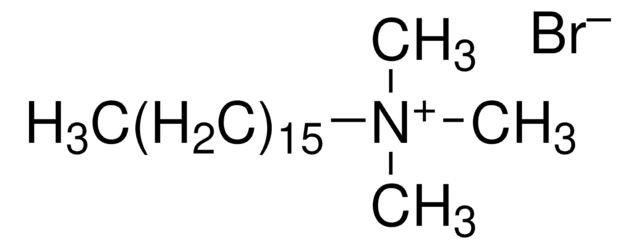360597
2,2,4-trimetilpentano
ACS reagent, ≥99.0%
Sinonimo/i:
Isoottano
About This Item
Prodotti consigliati
Grado
ACS reagent
Livello qualitativo
Densità del vapore
3.9 (vs air)
Tensione di vapore
41 mmHg ( 21 °C)
Saggio
≥99.0%
Stato
liquid
Temp. autoaccensione
745 °F
Limite di esplosione
6 %
Impurezze
≤0.0003 meq/g Water-soluble titr. acid
≤0.005% S compounds
Residuo dopo evaporazione
≤0.001%
Colore
APHA: ≤10
Indice di rifrazione
n20/D 1.391 (lit.)
P. ebollizione
98-99 °C (lit.)
Punto di fusione
−107 °C (lit.)
Solubilità
water: insoluble
Densità
0.692 g/mL at 25 °C (lit.)
Stringa SMILE
CC(C)CC(C)(C)C
InChI
1S/C8H18/c1-7(2)6-8(3,4)5/h7H,6H2,1-5H3
NHTMVDHEPJAVLT-UHFFFAOYSA-N
Cerchi prodotti simili? Visita Guida al confronto tra prodotti
Descrizione generale
Applicazioni
- Synthesis of polyethyleneimine /silica hybrid nanoparticles.
- Amino acid quantification process.
- To dissolve di(2-ethylhexyl) phosphoric acid(DEHPA) to form a solution that is used in the extraction and back extraction of methylene blue.
Avvertenze
Danger
Indicazioni di pericolo
Consigli di prudenza
Classi di pericolo
Aquatic Acute 1 - Aquatic Chronic 1 - Asp. Tox. 1 - Flam. Liq. 2 - Skin Irrit. 2 - STOT SE 3
Organi bersaglio
Central nervous system
Codice della classe di stoccaggio
3 - Flammable liquids
Classe di pericolosità dell'acqua (WGK)
WGK 2
Punto d’infiammabilità (°F)
10.4 °F - closed cup
Punto d’infiammabilità (°C)
-12 °C - closed cup
Scegli una delle versioni più recenti:
Possiedi già questo prodotto?
I documenti relativi ai prodotti acquistati recentemente sono disponibili nell’Archivio dei documenti.
I clienti hanno visto anche
Il team dei nostri ricercatori vanta grande esperienza in tutte le aree della ricerca quali Life Science, scienza dei materiali, sintesi chimica, cromatografia, discipline analitiche, ecc..
Contatta l'Assistenza Tecnica.





